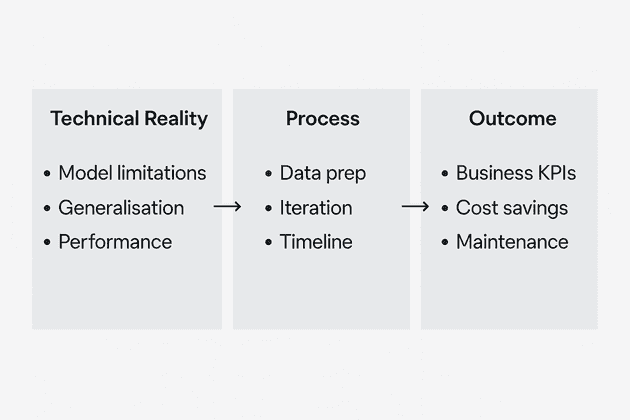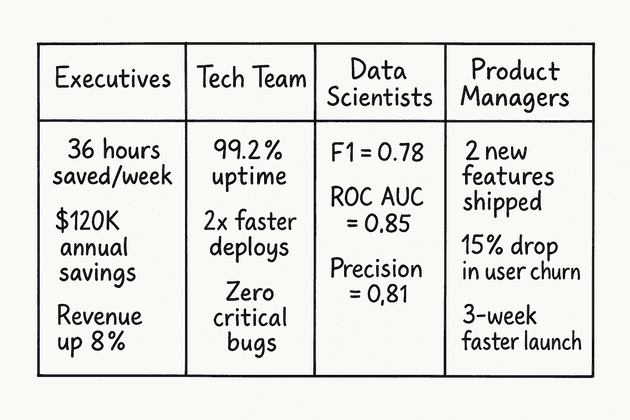The most successful AI projects I've led share a common trait and it's not superior technology or bigger budgets. It's a discipline that most companies overlook entirely: expectation setting.
By the end of this post, you'll understand how to master the three critical layers of AI expectation setting and implement four practical approaches that will dramatically improve your project outcomes.
Why AI Demands a New Approach
You need the right technology, talent, and infrastructure. Those are a given. But when AI projects fail, it's rarely due to technical shortcomings. Expectation setting makes or breaks them.
Expectation setting isn't a new idea, but it's especially critical in AI. Three key factors make it challenging:
1. The Hype Factor
- AI projects suffer from mismatched expectations more than other tech areas
- Media coverage creates unrealistic benchmarks
2. Hidden Complexity
- It's not always clear what AI can actually do (and what it can't)
- 'Hidden' work behind the scenes isn't obvious to stakeholders
- Example: Customers confused when data preparation is allocated a month
3. Non-linear Progress
- Traditional roadmaps promise features by set dates, but AI progress isn't linear
- You might reach 60% accuracy quickly, then spend months chasing 85%
- This affects both internal teams and external stakeholder expectations
The Three Layers Where AI Expectations Typically Fail
These challenges are why I've found it helpful to structure commonly missed AI expectation management across three categories:
- Technical Reality Expectations
- Process Expectations
- Outcome Expectations
Layer 1: Technical Reality Expectations
This layer addresses misalignments in understanding AI's capabilities. Stakeholders must grasp what the technology can realistically do, and critically, what it can't.
A key learning for me: I once had a client who was baffled when a model couldn't predict accurately on new data. They didn't understand the model's limits - how it struggles to generalise beyond what its seen in training. That wasn't just a technical detail. It nearly derailed the whole project.
Another common issue? Judging a model by a few cherry-picked bad predictions. It's smart to investigate failures, but that shouldn't define overall performance. Still, I see customers fixate on these outliers again and again.
Layer 2: Process Expectations
Process expectation setting is about aligning on AI project workflows. Stakeholders often express surprise at the data exploration timeline. They're eager for outcomes but are not always aware of the process needed to get there.
The cyclical nature of AI development is another area often needing alignment. AI projects rarely fit linear GANTT charts. Instead, they iterate: BUILD -> MEASURE -> LEARN feedback loops. This refines model performance through rapid experimentation, where many experiments can and should "fail".
These aren't failures, but valuable learning opportunities. Without careful expectation management however, these efforts risk being perceived as a lack of progress.
Layer 3: Outcome Expectations
Communicating AI project results demands a tailored approach. Internal or external, the audience dictates the level of detail and language used.
I've witnessed first hand executives visibly disengage as detailed F1-scores for a multi-class classifier were presented. The communication wasn't audience-appropriate. Execs and capital allocators need technical KPIs translated into business outcomes or cost savings to speak their language.
Model maintenance is another frequent point of misalignment related to outcomes. AI systems are rarely "fire and forget." Data distributions drift, requiring maintenance in the form of monitoring and periodic model retraining or refreshing the data.
Revolutionary Approaches for the AI Era
Recognising these three layers reveals common pain points. Despite this, traditional approaches to expectation management often perpetuate the problems they attempt to solve. Below are four approaches I use that directly address these challenges.
1. Create dual reporting structures
Dual reporting means sharing content that is tailored to the audience. Remember the executive who disengaged during F1-score discussions (Layer 3)? Same project, different languages. What matters to one group may be irrelevant to another.
2. Frame expectations through cost of omission rather than the benefits of inclusion
When clients question the month allocated for data preparation (Layer 2). Instead of defending the timeline, flip the conversation and help explore what happens without data preparation work. Raise the question: "What's the cost of NOT doing this step?" Frame it in terms of outcomes the stakeholder is primarily concerned with - predictive accuracy, frauds detected, chatbot hallucinations. This is not about being negative, it's about transparency and clarity on the importance of certain parts of a project.
3. Create a failure library documenting every dead end, flawed assumption or failed experiment
For stakeholders who view AI iteration as a lack of progress (Layer 2), a failure library reframes setbacks as assets. When teams document what didn't work, "failure" becomes intelligence. This compounds as new people join. Instead of repeating dead ends, they see what's been tried. Smart teams track failures, not just wins. Document every wrong turn.
4. Preemptively reframe project paradigms
The fourth technique is straightforward but powerful: explicitly reset project paradigms from the outset.
Before kickoff, hold dedicated sessions where you clearly establish: "This AI project will not look like traditional technology projects." Outline the specific differences in timeline patterns, evaluation metrics, and delivery cadence.
This preemptive paradigm shift prevents stakeholders from applying the wrong mental models from previous experience. By addressing these differences explicitly and early, you establish new criteria for success before misaligned expectations can take root.
To do this effectively, use concrete language and analogies that connect AI to business realities.
Conclusion
Expectation setting is more than a project management checkbox; it’s often the difference between AI that delivers and AI that doesn’t. The best leaders manage mindsets as well as timelines.
In AI projects, the real challenge isn’t simply a lack of knowledge, but the need for behavioral change. Think of it like marathon training: progress isn’t linear, and setbacks are part of the journey. Failed experiments and plateaus in model performance aren’t signs of failure - they’re essential steps in development.
To improve outcomes, start by mapping out the three layers: technical reality, process, and outcomes. Identify where expectations are most misaligned. Use dual reporting, frame the cost of skipping steps, document failures, and reset project paradigms before misconceptions take root.
Perfection isn’t required. What matters is being clear, honest, and adaptable. In AI, progress comes from learning and doubling down on what works.


